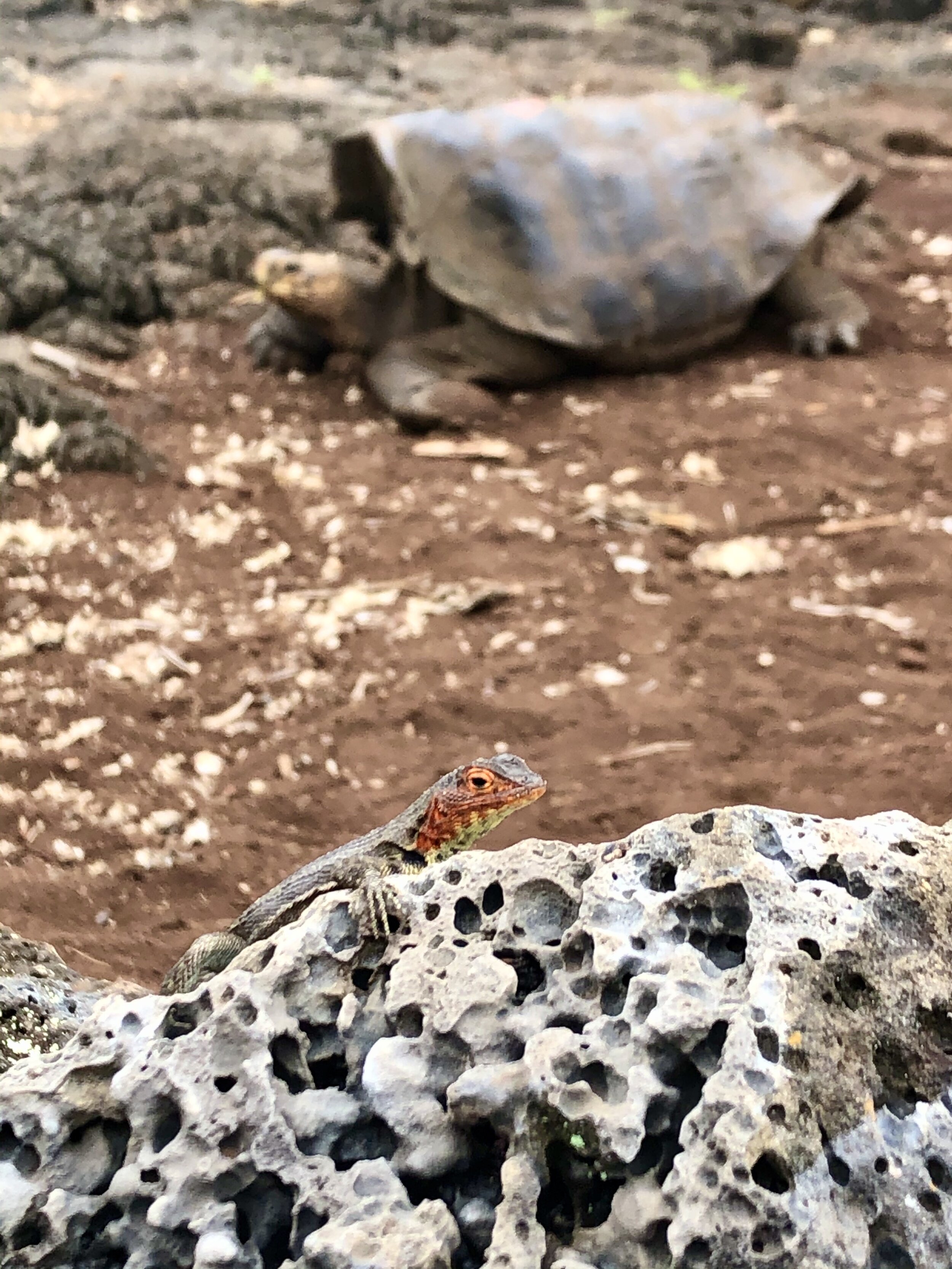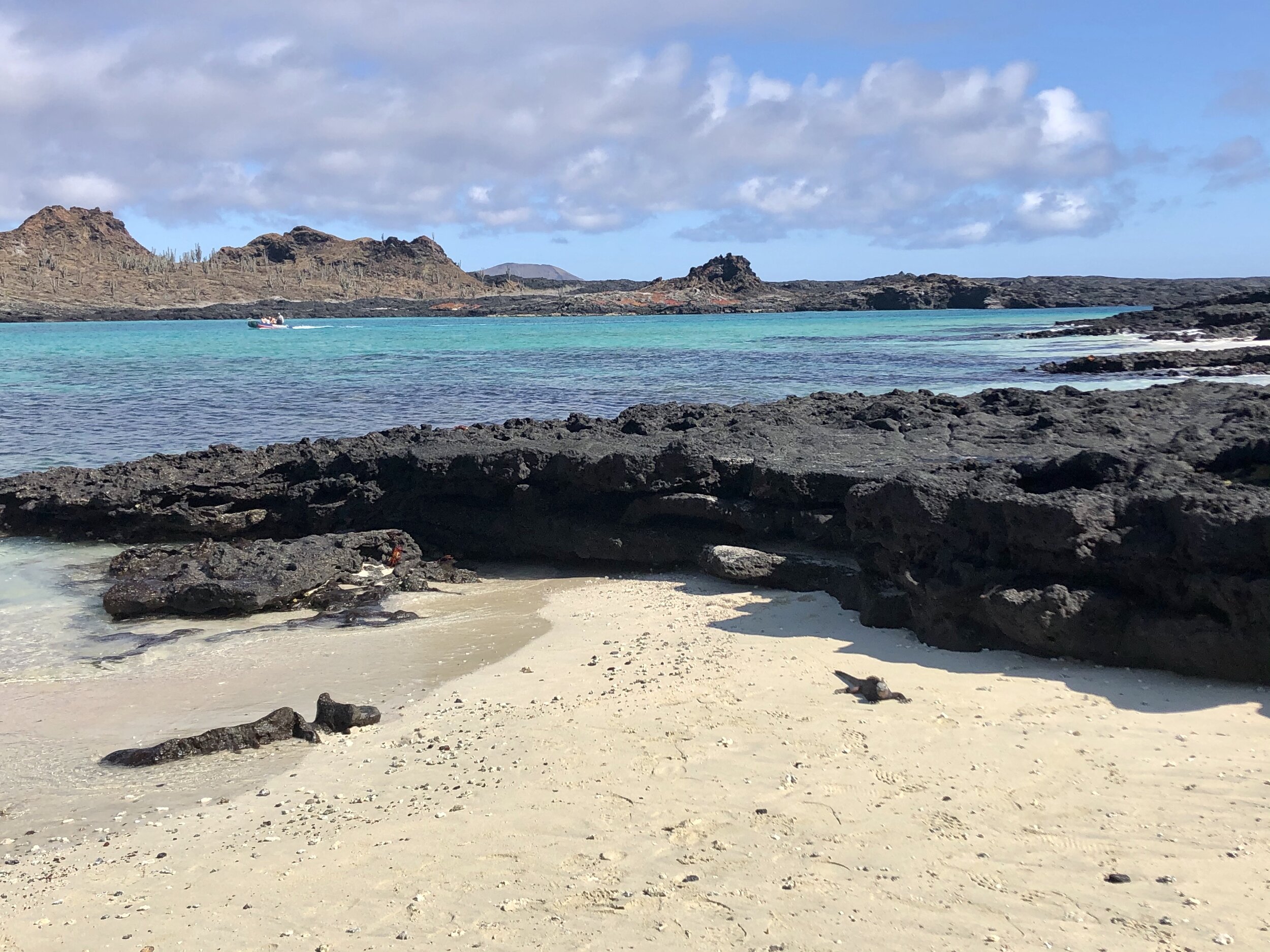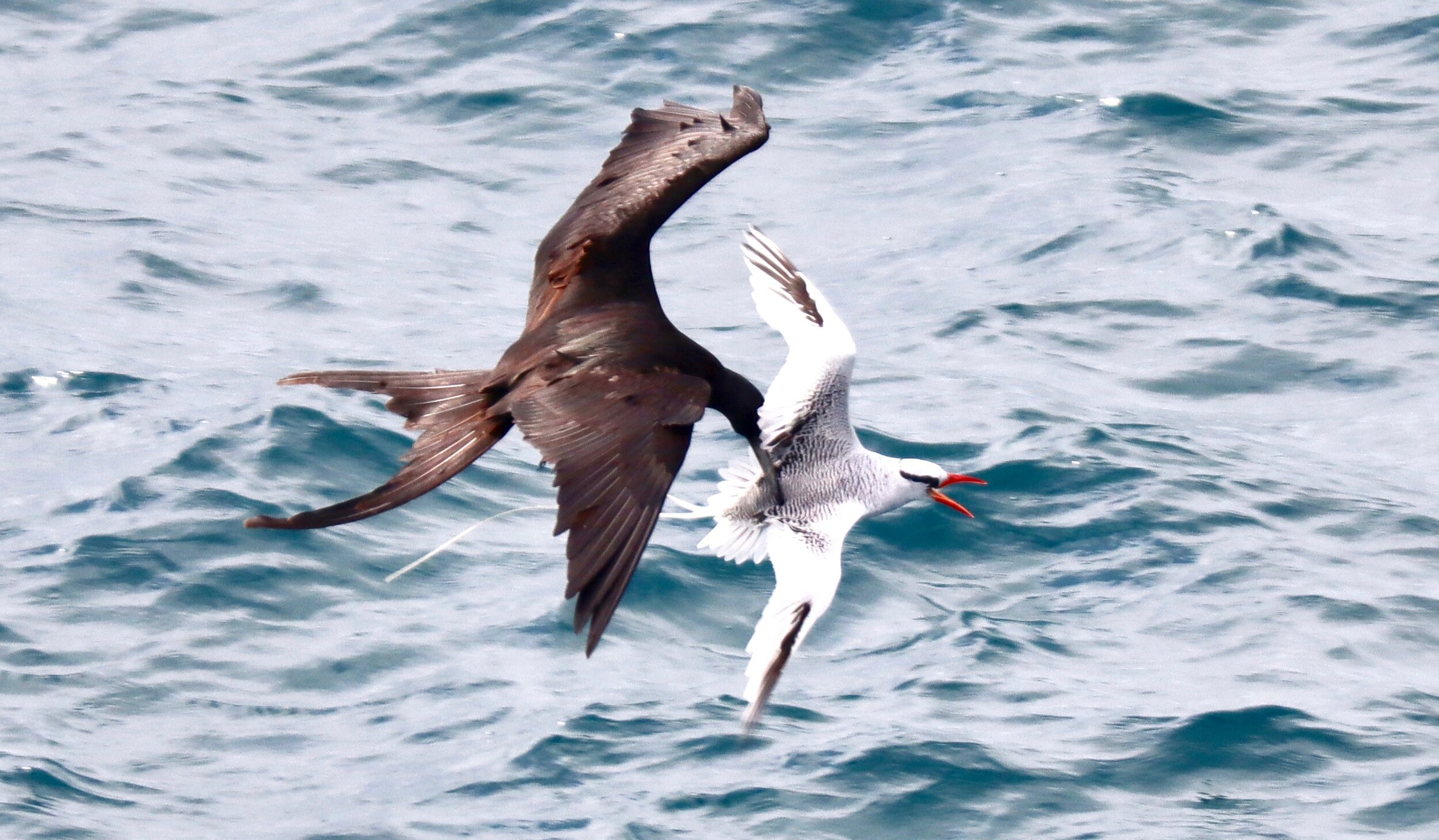Archipel II
The Galápagos is one of those places that in order to do it right, you really need to find a good boat. There are so many nooks and crannies and places that you can’t reach unless you have pangas to get you on shore. And of course, many of the islands have no towns, roads, or modern habitat-destroying conveniences. We were incredibly lucky on board the Archipel II. The group of tourists were all friendly and talkative, and the crew (though most of them knew very little English), still managed to make me laugh, and were very accommodating. And the FOOD was delicious. Sad to say but happy to report that I ate more vegetables there than I had in the past 6 months of my life. Today’s post is a little tribute to the catamaran that was my home for a week (with a few repeat photos from the first Galápagos blog post).
bonbon treats on my bed!
When I returned, my glasses had sprouted a towel in the shape of a ray! And some chocolates for eyes. I absolutely loved seeing this after coming back sweaty and tired.
Our dining area and wet suits hanging up to dry on the deck.
Another masterpiece!
Someone is very good at making sculptures of animals out of everyday objects!
Napping on the deck.
release the pangas!
Again, thank again to an excellent crew! Salud!
Galápagos: Puerto Ayora
*storm-petrel cover photo by Athene Blakeman
We made landing on the other side of Santa Cruz island from where we last were (Cerro Dragon). We arrived on the solid ground of Puerto Ayora, the largest town in the Galápagos at around 12,000 people. It is also home to multiple giant tortoise breeding programs, including at the Charles Darwin Research Station. We had the day to wander the town, find internet (!) (we had no wifi on the boat), go to a corner store, and generally have a little freedom from the normally active itinerary.
A very unique Catholic church with beautiful stained class and murals — on Av. Charles Darwin nonetheless. And of course, it is no surprise to see St. Francis on the right side, the patron saint of animals (and namesake of the Franciscan order, of which this church is a member). Note the tortoise on the left looking over to him with curiosity, or longing?
A peek inside the church.
Some of the architecture on Ave Charles Darwin.
Iguanas are so nonchalant, and can rest anywhere they like without worrying about people bugging them.
At the fish market, where sea lions begged for scraps like dogs!
Looking out onto Academy Bay.
A bust of Darwin on the way to the research institute.
Up next: a trip to see the amazing Galápagos tortoises!
Galápagos: Cerro Dragon
As we made our way from Chinese Hat to Dragon Hill (so named (I hope) because of its large colony of mini dragons: land iguanas!), we first passed by this insane crater island called Bainbridge Rocks. The ocean water is cut off from the lagoon, so it is a very safe spot for pink flamingos to rest.
We crept up to the rocks as close as our boat could safely go, then peering over the edge, we saw a flock of flamingos! They are those pink things on the far shore of the lagoon. Zoom in if you can! (And don’t worry, I got much closer to flamingos later on in the trip.) What an amazing oasis!
Next, we zipped onto Cerro Dragon, which has the only colony of land iguanas on all of Santa Cruz island.
Do you see the iguana in the above image? In the center? They blend in so well that I often did see them until I was right next to them.
Great blue heron!
The salt water lagoon with tons of birdlife.
Dried salt from the lagoon that you sometimes see iguanas lickin’ up.
I would hide under the shade of that bush too.
Galápagos: Sombrero Chino
A typical day on the boat went something like this:
On this particular day, our first stop was at Sombrero Chino (“China hat” in English), so named because the old remains of the volcanic cone taper upward and stop at a plateau, looking very similar to the shape of a …Chinese hat.
This is one of the best places in the Galápagos to see marine iguanas (Amblyrhynchus cristatus). There are innumerable individuals on this particular island (I’m sure someone has tried to numerate it, but it’s not easy enough to find!). The landscape is that of a barren, hot, lava field. Marine iguanas eat mainly underwater plant life. They can survive underwater for longer than other iguanas — up to an hour! They can dive 15 or so feet to the bottom and then using their claws to cling to the rocks while they eat algae. They take in a lot of sea water when they swim. They have a clever adaptation to deal with the excess salt - they store it in a special sac behind their sinuses and then sneeze out the salt, expelling it from their system. It’s not uncommon to see a lot of marine iguanas lazing around together, casually blowing salt water out of their noses. Here’s a link to an excellent video of the sneezing: https://youtu.be/6G6ZL0fbLHQ.
Below is my own video of a colony of sun-basking iguanas.
The top of the sombrero in the background, Paola in the foreground.
Lava fields and “hornitos” (little ovens) cover the landscape.
Far in the background, you can see a mountain peak tall enough to create its own weather:
Looking out from Sombrero Chino over to Isla Santa Fe.
Do you spy the penguin??!!
And, finally, a few more snorkeling videos of white-tipped reef sharks and swimming penguins!
Next up: Cerro Dragon
Galápagos: Snorkeling pt. II
Enjoy this compilation of videos from our time snorkeling! We snorkeled almost everyday, and I would do it again in a heartbeat.
Galápagos: Isla Santa Fe
*cover photo by Athene Blakeman.
Our next stop on Day 2 was Barrington Bay, a beautiful little bay on the coast of Santa Fe Island. As soon as we entered the bay on the pangas, we were greeted by a group of sting rays!
The Archipel II centers the frame!
The best part about Barrington Bay was its huge colony of endangered Galápagos sea lions (Zalophus wollebaeki). As soon as we got there, a curious and territorial male began parking at us from across the beach, running in and out of the water and swimming back and forth. There were also so many sea lion pups!
A word about how close I seem to be to the pup: We were instructed to maintain a 2m radius around the animals. Despite our diligence, sometimes animals were unavoidably close. This sea lion and many others nearby were parked right in the middle of the walking path. They didn’t seem to mind our presence (which is another fascinating side note about the Galápagos wildlife - they allow such close proximity in large part due to their lack of predators), so we carefully did our best to circumvent them. And camera zoom helps a lot too.
See the lizard on the baby sea lion to the right and another lizard on a rock above the adult sea lion to the left? As these sea lions sleep and lounge, they are ravaged by flies. The lava lizard is a mutualist with the sea lions (and other creatures), whereby lizards hop up on top of the sea lions and catch flies, so it’s not uncommon sight to see so many lava lizards nearby sleeping lions.
Getting some use out of my new Moment macro lens for my iPhone.
Lava lizard! I made friends with this one. Flies were swarming on me and as I swatted them, the lava lizard would immediately pluck them from the ground. I was closely watched.
Hermit crab! I love the pattern it makes in the sand.
At the end of the day, coming back onto the boat with these guys was a treat. Our brilliant naturalist guide, Paola, is 2nd to right. (And she’s starting a PhD program at Arizona State this fall!)
Because I would find things like this on my bed — a ray with my glasses and little chocolates for eyes.
It doesn’t get much better than this.
Galápagos: Isla Plaza Sur
Isla Plaza Sur, Isla Santa Cruz
On the second day, we traveled from Isla San Cristóbal to Isla Plaza Sur, a small island off the coast of the larger Isla Santa Cruz (there is also an Isla Plaza Norte, but it’s off-limits to humans).
Each day began with a nearby walk. We would hop on the pangas (aka “little boats” in Spanish, another word for a dinghy), and zoom up to a beach or a rocky outcrop, and then spend an hour or more roaming the island with Paola as our guide. I tried to write down as much as I possibly could to varying degrees of success.
The Galápagos are a series of volcanic islands, and the islands in the west of the archipelago are younger than the islands to the east. The Galápagos are relatively young, geologically speaking, arising around 5 million years ago. As species from the mainland began to colonize the different islands by air or by sea, populations diverged from their ancestral groups. Some of the western-most islands, which have the most volcanic activity, may be only hundreds of thousands of years old. As islands formed, animals and plants continued to move westward. Many of the species on each island are closely related to others in the Galápagos, but they have subtle differences.
(click on the below maps to make them bigger)
Land iguana (Conolophus subcristatus). This small island of Isla Plaza Sur is one of the best places in all of the Galápagos to see land iguanas.
The top left image shows a number of land iguana burrows. During his voyage to the Galápagos, Darwin wrote,
We could not for some time find a spot free from their burrows on which to pitch our single tent. (Darwin, 1839, “Voyage of the Beagle”)
A project by researchers and volunteers from the Darwin Research Institute. They are attempting to grow a field prickly pear cacti, which used to be abundant on this island. The cacti are vulnerable until a certain age, which is why there are cages around them to prevent predation by land iguanas.
Oh, and remember that owl from the previous Galápagos birds post? The Galápagos short-eared owl (Asio flammeus ssp. galapagoensis) staring into your soul?
Well, you can tell when one has been around when you see wings of other birds on the ground. Almost as though the body disappeared and left the wings perfectly in place. They grab their prey, typically an unsuspecting shearwater bird, and devour everything but the wings, as shown below.
Galápagos: Isla San Cristóbal
Now that I have the time, I am going to start a series of posts from the Galápagos tour, which was back in January!
—
Upon arrival to the San Cristóbal Airport near Puerto Baquerizo Moreno (the capital of the Galápagos) on the Isla de San Cristóbal, we met our guide Paola and were shuttled to the dock, hopped on a dinghy, and scuttled to our home for the next week: Archipel II (yes, there is an Archipel I, but it’s just “Archipel”). It was a lovely little catamaran that housed about 15 of us at a time, plus the crew. We all came from North America or Europe. And most others had excellent cameras, including Athene Blakeman, whose photos I will mention when I post them but it’s probably going to be quite obvious.
Like this one, the Galápagos yellow warbler (Setophaga petechia aureola), taken by Athene:
The flight into Isla San Cristóbal. This is the northeast side of the island.
My bunk on the boat!
A view of the bay of Puerto Baquerizo Moreno.
sunset
The top deck! Many naps were had here.
Lava lizard! Get ready to see a lot of these cuties. Photo by Athene Blakeman.
Galápagos sea lion swimming! Photo by Athene Blakeman.
Galápagos Birds
I can’t even begin to describe what a feast on the eyes and mind the Galápagos Islands were. I spent 7 days on a catamaran with 14 other tourists and a full crew. Our guide, Paola, was a native to the islands and had an encyclopedic memory of all flora, fauna, geology, culture, etc. There was hardly a question that she did not know the answer to. To give you a taste, I am highlighting here the photography of Athene Blakeman, a brilliant photographer with whom I was lucky to share a boat for a week. These are a taste of the animals we saw, and I will continue to add more of my own pictures and stories to complement her excellent eye. Nearly everything in these photos she and I saw together, so it does not feel disingenuous to show my own experience through her lens.
Blue-footed boobies (Sula nebouxii). Both males and females have blue feet. Their name comes from the Spanish word for clown or fool [bobo] because they lift their feet up dramatically and dance to attract their mates (as shown here). It is a sexually selected trait, so the bluer the feet, the more desirable the male to the female. The blue comes from carotenoids from a healthy diet of fresh fish. Carotenoids are good for the immune system. Thus, the blue feet are a good representation of the bird’s immune health.
One of the 17 finch species found in the Galápagos!
A juvenile magnificent frigatebird (Fregata magnificens). These birds are all over the Galápagos (along with a very similar species, the great frigatebird (Fregata minor)). They soared alongside our boat as we moved from island to island. They are known as kleptoparasites, meaning they occasionally rob food from other birds. Tropicbirds, shown below, are often a victim of this thievery.
The red-billed tropicbird (Phaethon aethereus), shown flying in search of food. See the long tail? The frigatebird can grasp the tail and pull the tropicbird towards it until can hold on to the tropicbird’s body with its beak.
Frigatebird grabbing a tropicbird to make it vomit up its recent catch of food.
There were about 5 frigatebirds chasing this poor tropicbird. The good(ish) news is that this type of food acquirement is relatively less frequent than gaining food by other means, but still, tropicbirds always have to be on the lookout!
Short-eared owl (Asio flammeus galapagoensis). Isn’t this owl incredible? It is somewhat uncommon to be out and about during the day, so we weren’t expecting to see one. And yet, it was one of the very first birds we saw on the first hike of our tour (Isla Plaza Sur). This one was sitting patiently, looking a bit annoyed at us. We noticed a bunch of bird wings nearby and figured it was digesting a nice, big breakfast. It is known to grab petrels (another type of bird) and only eat the bodies, discarding the wings. It is common to find bird wings on the ground, placed perfectly, as though the bird’s body simply disappeared and left the wings behind.
More photos to come soon!
And again, all photography here is by the talented Athene Blakeman.










































































































































![Blue-footed boobies (Sula nebouxii). Both males and females have blue feet. Their name comes from the Spanish word for clown or fool [bobo] because they lift their feet up dramatically and dance to attract their mates (as shown here). It is a sexua…](https://images.squarespace-cdn.com/content/v1/5deefba5fbe89c56400f287f/1580672840101-VR4AEMDVLVK9R8Y2ZRUZ/Boobies.jpeg)




